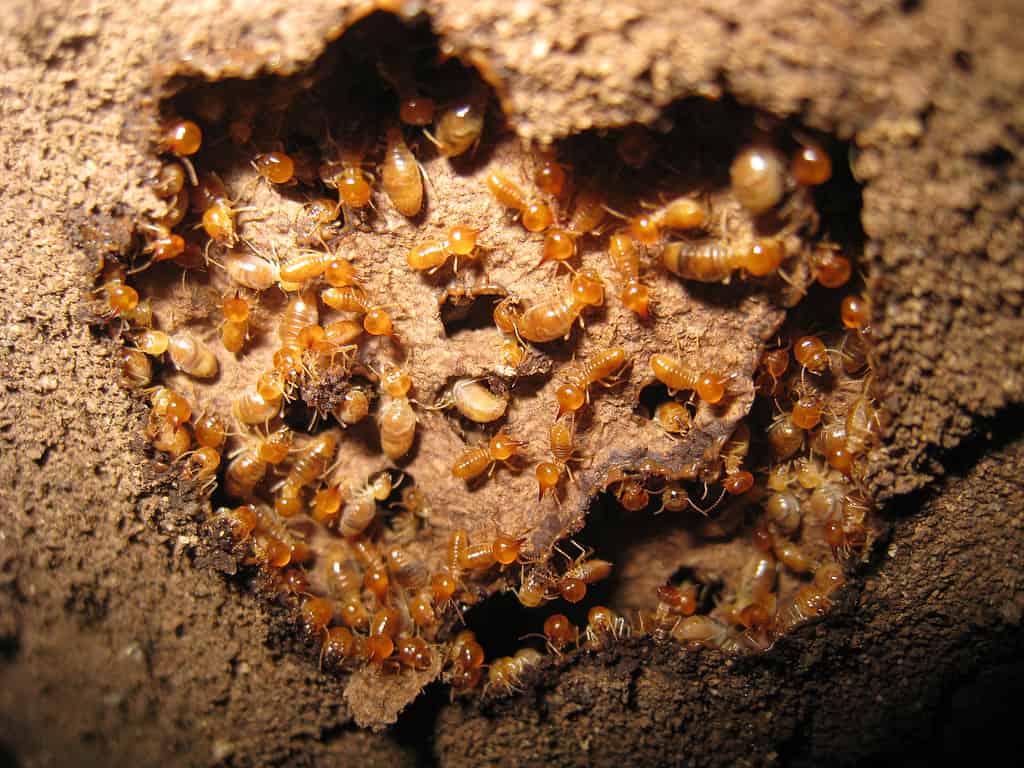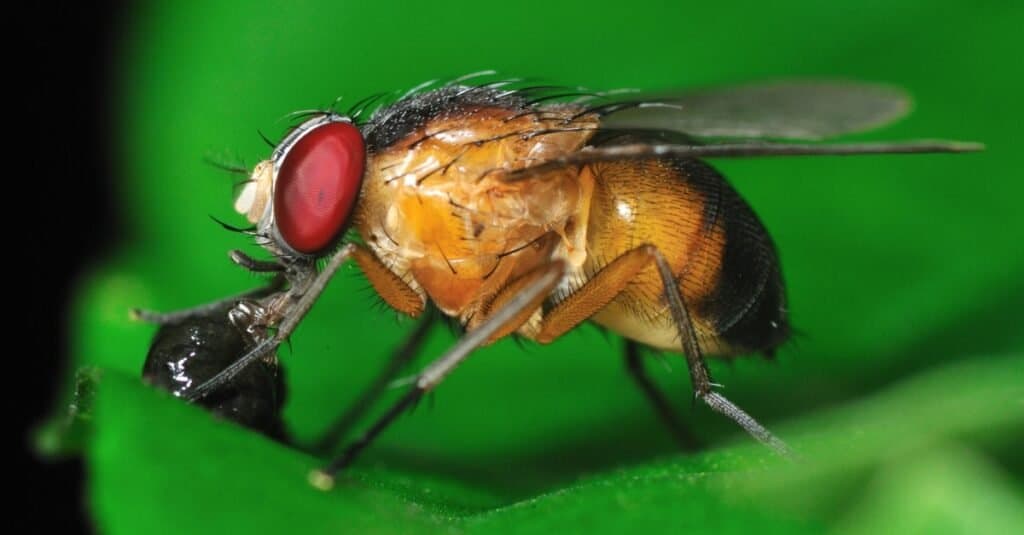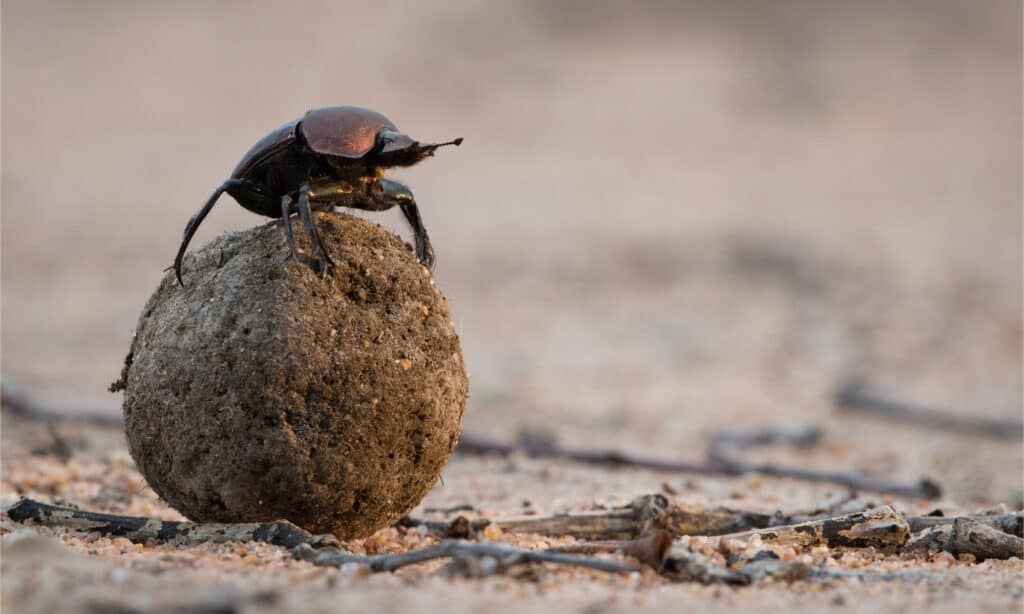Detritivores are beings that consume decaying matter as their primary food. Herbivores eat vegetation, and carnivores eat meat. Well, detritivores eat things that are already decaying.
Of course, just about everyone learned about herbivores and carnivores at some point in their education. However, very few people have ever heard of detritivores despite their very important role in the ecosystem.
What is an Example of a Detritivore?

Termites are one of the most notorious detritivores but are very efficient at their job.
©Cheng_Wei/iStock via Getty Images
While they do eat decaying things, detritivores aren’t exactly decomposers. Unlike your average decomposer, detritivores actually consume dead things – not just absorb the nutrients. Of course, dead things are on the menu, but many detritivores also eat fecal matter.
“Detritivores” may seem like a long, alien word, but you’ve likely met some of these critters in your daily life. Snails, slugs, and flies are common examples. Termites are very specialized detritivores, as they only consume rotting wood. Male mosquitoes are also detritivores (only females suck our blood; the males get a much messier meal).
Roly-polies and similar woodlice also get much of their nutrition from decaying things. Even if you haven’t seen one in real life, you probably know what a dung beetle is. These specialized beetles eat fecal matter and are famously known for making balls of poop, in which they lay their eggs.
Tons of fish and other creatures in bodies of water are also detritivores. In water, nutrients tend to flow downwards. Therefore, practically anything that lives near the bottom is a detritivore. Most starfish and crab species fall into this category, but you’ll also find sea cucumbers and catfish. Many anemones fall into this category, as they’ll often left to filter whatever food particles come their way.
Plus, the ocean and lakes are also home to hundreds of insect species that pick up whatever small bites of waste they find.
Can Plants Be Detritivores?
You’ll notice that plants are absent from our list above. This exclusion is because plants don’t really eat things. Therefore, they’ll fall into the decomposer category but can’t be considered detritivores – with one exception.
Nepenthes ampullaria is a pitcher plant. Most of these species entice insects into their “belly” and digest them. However, this particular species also collects and eats any plant matter that happens to fall into it. Falling leaves are the most common item on the menu.
Why Are Detritivores Important?

Fruit flies are another common detritivore, eating most decaying fruit.
©Jordan Lye/Shutterstock.com
Yes, the diet of a detritivore isn’t exactly something we would want to try ourselves. (Or should try, given that we would almost absolutely get sick.) However, it is an evolutionary diet that allows insects, fish, and even a plant to take advantage of “wasted” nutrients all around them. Nature is quite efficient, after all.
Most detritivores have evolved to consume very specific waste or dead animals. However, others are more generalized. They’ll consume just about anything with nutrients if it isn’t moving. (Take the common housefly, for instance.)
Detritivores also play a key role in decomposing and reusing nutrients in the ecosystems they inhabit. Without decomposers like them, waste and dead things would stay around almost indefinitely. We can all agree that we’d rather have flies turn feces into energy than leave them lying around, even if they annoy us occasionally.
Of course, there are lots of decomposers that can do this job. Detritivores do tend to do much of the heavy lifting of the initial decomposing steps, though. Until the feces or dead animal begins to break down, the bacteria and fungus that decompose it cannot get in. Detritivores aren’t deterred by a dead animal’s skin, for instance, and once they’re through, other decomposers can join them.
Some decomposers may even carry bacteria and fungus from meal to meal, speeding up the decomposition process. Some species of fungi even require transportation on the back of a fly or snail.
How do Detritivores Work?

Vultures are commonly considered “scavengers,” as they don’t only eat decaying matter. However, animal carcasses often make up a large part of their diet.
©faisal magnet/Shutterstock.com
Detritivores are known for being very efficient, and this efficiency is due to their unique adaptations that make consuming decaying nutrients possible. Most species have a range of physical and social traits that allow them to consume dead matter efficiently.
For instance, most insects that are detritivores have very specific mouthparts that evolved to make eating tougher dead matter possible. All detritivores also have to evolve specialized enzymes that can allow them to break down dead matter without getting sick. For example, vultures have special bacteria in their stomachs that allow them to consume dangerous pathogens without getting sick.
This specialized digestive system allows detritivores to eat things that would only make us sick.
Many detritivores are rather small. Therefore, most participate in communal eating, which allows them to break down the tougher parts of decaying matter efficiently. If you come across something dead, there are going to be many flies – not just one. Many beetles also consume the same pile of leaves or plant matter.
Some insects are more organized with their communal feeding. Ants are a great example of this. Not only will you find many eating the same thing, but they have evolved a whole social structure to do just that.
Many detritivores have symbiotic relationships with other detritivores (or scavengers with similar food sources). For instance, the bacteria inside of a vulture’s stomach fall into this category. They break down and consume some of the nutrients vultures eat, and the vulture gets to eat decayed matter in exchange.
Detritivores also have to find their food, which is often easier said than done. Most have specialized sensory organs that allow them to hone in on the chemical signals of decaying matter. To put it simply, they’re very good at “smelling” dead things.
Detritivores in Different Ecosystems

Dung beetles are an example of a very specialized detritivore, as opposed to a more generalist detritivore like a fly.
©Villiers Steyn/Shutterstock.com
Most detritivore species are found in mature woodlands. In forests that have been around for decades, there tends to be a lot of dead material on the forest floor. Therefore, plenty of detritivores may thrive in this ecosystem. Beetles, ants, and termites are great examples of detritivores that are common in mature woodlands.
In aquatic ecosystems, detritivores are also common, as we discussed above. The organic matter at the bottom of the rivers, lakes, and oceans is often full of invertebrates that spend their life eating whatever floats down. These organisms help prevent dead matter from accumulating at the bottom of the water and ruining the water quality.
You might not expect detritivores to be in deserts. However, many specialized beetles and other insects have adapted to utilize the decaying matter found in the desert. Often, these insects have very good water-conservation mechanisms, allowing them to thrive in arid environments.
Tropical rainforests are full of decaying matter, as well. Ants, millipedes, and beetles are the most common detritivores in most rainforest environments. They play a key role in recycling nutrients in this very wet environment, allowing the biodiversity the rainforest is famous for.
You can even find some detritivores in urban environments. For instance, ants are very common in these areas, as are other insects drawn to decaying matter. Rats even play the role of detritivores in some urban areas (though rats are usually referred to as omnivores).
The Most Interesting Detritivores
Some detritivores have particularly interesting adaptations and behaviors. Here are some of them:
- Dung Beetles: Most people know what a dung beetle is. However, you may not know that some species of dung beetles navigate using the Milky Way, making them one of the few insects known to use the night sky for navigation.
- Woodlice: Despite some common misconceptions, roly-polies are not actually insects. Instead, they’re crustaceans and closely related to crabs and lobsters. Therefore, it makes sense that they would be detritivores like most crabs.
- Termites: Termites are one of the most commonly known detritivores. However, they actually have a symbiotic relationship with fungi, which helps them break down the tough cellulose found in wood. Without the fungi, the termites wouldn’t be able to efficiently breakdown wood like they do.
- Carrion Beetles: As the name suggests, carrion beetles eat animal carcasses. However, these beetles are also known for locating and burying dead animals, preventing the spread of diseases.
- Earthworms: These classic detritivores are indicators of soil health, as they need rich soil to find enough nutrients to survive. Many gardeners purposefully add earthworms to their soil.
- Cockroaches: These insects are best known for living in filthy conditions. However, they are some of the most effective detritivores, with some even being able to digest cellulose effectively.
- Antarctic Mites: These detritivores are one of the very few that can live in the harsh environment of Antarctica. They consume dead organisms located in the tundra.
- Vultures: Vultures can consume dead matter thanks to the enzymes and bacteria in their stomach. Their stomach acid is also extra acidic, killing many pathogens before they can make the bird sick.
The photo featured at the top of this post is © Nick N A/Shutterstock.com
Thank you for reading! Have some feedback for us? Contact the AZ Animals editorial team.






